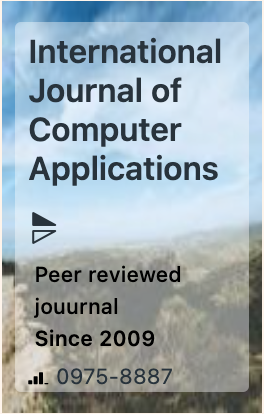The week's pick
Random Articles
Reseach Article
Optimizing Alzheimer's Disease Detection: An Enhanced Approach Weight-based Beetle Swarm Optimization with SVM
| International Journal of Computer Applications |
| Foundation of Computer Science (FCS), NY, USA |
| Volume 186 - Number 61 |
| Year of Publication: 2025 |
| Authors: Eman M. Ali, Mohamed A. Mahfouz, Howida Y Abd ElNaby |
 10.5120/ijca2025924386
10.5120/ijca2025924386
|
Eman M. Ali, Mohamed A. Mahfouz, Howida Y Abd ElNaby . Optimizing Alzheimer's Disease Detection: An Enhanced Approach Weight-based Beetle Swarm Optimization with SVM. International Journal of Computer Applications. 186, 61 ( Jan 2025), 17-27. DOI=10.5120/ijca2025924386
Abstract
It is essential for radiologists to identify Alzheimer's disease early to ensure accurate diagnosis and access to treatment. Medical imaging, such as Magnetic Resonance Imaging (MRI), are becoming increasingly difficult to diagnose. This study sought to develop a hybrid framework to use MRI scans to detect Alzheimer's disease. The suggested approach entails applying adaptive median filtering as a pre-processing step to MRI scans, extracting features based on hybrid wavelet partial Hadamard transform (hybrid WPHT) and discrete local binary pattern (DLBP). The next step in the feature selection process is to reduce the dimensionality of the features using the adaptive Harris-Hawk optimization (AHHO) approach. This greatly enhances the performance of the classifier by further refining its parameters using the Improved Weight-Based Beetle Swarm algorithm (IW-BS) and the Optimized Support Vector Machine (OSVM) classification. The MRI image classifies as Mild, Very Mild, or Normal. The results of the study demonstrate that this proposed methodology is more accurate, precision, and recall, specificity, F-score, running time, under the curve (AUC), and receiver operating characteristics (ROC)
References
- A.A.A. El-Latif, S.A. Chelloug, M. Alabdulhafith, M. Hammad, Accurate Detection of Alzheimer’s Disease Using Lightweight Deep Learning Model on MRI Data, Diagnostics. 13 (2023) 1216. https://doi.org/10.3390/diagnostics13071216.
- J. Cummings, Y. Zhou, G. Lee, K. Zhong, J. Fonseca, F. Cheng, Alzheimer’s disease drug development pipeline: 2023, Alzheimer’s & Dementia: Translational Research & Clinical Interventions. 9 (2023) e12385. https://doi.org/10.1002/trc2.12385.
- W.M. van der Flier, M.E. de Vugt, E.M.A. Smets, M. Blom, C.E. Teunissen, Towards a future where Alzheimer’s disease pathology is stopped before the onset of dementia, Nat Aging. 3 (2023) 494–505. https://doi.org/10.1038/s43587-023-00404-2.
- A.G. Vrahatis, K. Skolariki, M.G. Krokidis, K. Lazaros, T.P. Exarchos, P. Vlamos, Revolutionizing the Early Detection of Alzheimer’s Disease through Non-Invasive Biomarkers: The Role of Artificial Intelligence and Deep Learning, Sensors (Basel). 23 (2023) 4184. https://doi.org/10.3390/s23094184.
- Researchers propose a novel biomarker for early diagnosis of Alzheimer’s disease | Karolinska Institutet Nyheter, (n.d.). https://news.ki.se/researchers-propose-a-novel-biomarker-for-early-diagnosis-of-alzheimers-disease (accessed September 23, 2023).
- Y. Ding, J.H. Sohn, M.G. Kawczynski, H. Trivedi, R. Harnish, N.W. Jenkins, D. Lituiev, T.P. Copeland, M.S. Aboian, C. Mari Aparici, S.C. Behr, R.R. Flavell, S.-Y. Huang, K.A. Zalocusky, L. Nardo, Y. Seo, R.A. Hawkins, M. Hernandez Pampaloni, D. Hadley, B.L. Franc, A Deep Learning Model to Predict a Diagnosis of Alzheimer Disease by Using 18 F-FDG PET of the Brain, Radiology. 290 (2019) 456–464. https://doi.org/10.1148/radiol.2018180958.
- J. Samper-González, N. Burgos, S. Bottani, S. Fontanella, P. Lu, A. Marcoux, A. Routier, J. Guillon, M. Bacci, J. Wen, A. Bertrand, H. Bertin, M.-O. Habert, S. Durrleman, T. Evgeniou, O. Colliot, Reproducible evaluation of classification methods in Alzheimer’s disease: Framework and application to MRI and PET data, NeuroImage. 183 (2018) 504–521. https://doi.org/10.1016/j.neuroimage.2018.08.042.
- I. Beheshti, H. Demirel, F. Farokhian, C. Yang, H. Matsuda, Structural MRI-based detection of Alzheimer’s disease using feature ranking and classification error, Computer Methods and Programs in Biomedicine. 137 (2016) 177–193. https://doi.org/10.1016/j.cmpb.2016.09.019.
- Alzheimer’s Disease Diagnosis Using Landmark-Based Features from Longitudinal Structural MR Images, (n.d.). https://ieeexplore.ieee.org/document/7929275/ (accessed September 24, 2023).
- N. Zeng, H. Qiu, Z. Wang, W. Liu, H. Zhang, Y. Li, A new switching-delayed-PSO-based optimized SVM algorithm for diagnosis of Alzheimer’s disease, Neurocomputing. 320 (2018) 195–202. https://doi.org/10.1016/j.neucom.2018.09.001.
- J.E.W. Koh, V. Jahmunah, T.-H. Pham, S.L. Oh, E.J. Ciaccio, U.R. Acharya, C.H. Yeong, M.K.M. Fabell, K. Rahmat, A. Vijayananthan, N. Ramli, Automated detection of Alzheimer’s disease using bi-directional empirical model decomposition, Pattern Recognition Letters. 135 (2020) 106–113. https://doi.org/10.1016/j.patrec.2020.03.014.
- JPM | Free Full-Text | Deep Learning-Based Diagnosis of Alzheimer’s Disease, (n.d.). https://www.mdpi.com/2075-4426/12/5/815 (accessed October 28, 2023).
- M. Liu, D. Cheng, W. Yan, Alzheimer’s Disease Neuroimaging Initiative, Classification of Alzheimer’s Disease by Combination of Convolutional and Recurrent Neural Networks Using FDG-PET Images, Frontiers in Neuroinformatics. 12 (2018). https://www.frontiersin.org/articles/10.3389/fninf.2018.00035 (accessed September 24, 2023).
- P. Vemuri, H.J. Wiste, S.D. Weigand, L.M. Shaw, J.Q. Trojanowski, M.W. Weiner, D.S. Knopman, R.C. Petersen, J. C R. Jack, O. behalf of the A.D.N. Initiative, MRI and CSF biomarkers in normal, MCI, and AD subjects: Predicting future clinical change, Neurology. 73 (2009) 294. https://doi.org/10.1212/WNL.0b013e3181af79fb.
- S. Basaia, F. Agosta, L. Wagner, E. Canu, G. Magnani, R. Santangelo, M. Filippi, Automated classification of Alzheimer’s disease and mild cognitive impairment using a single MRI and deep neural networks, NeuroImage: Clinical. 21 (2019) 101645. https://doi.org/10.1016/j.nicl.2018.101645.
- D. Pan, A. Zeng, L. Jia, Y. Huang, T. Frizzell, X. Song, Early Detection of Alzheimer’s Disease Using Magnetic Resonance Imaging: A Novel Approach Combining Convolutional Neural Networks and Ensemble Learning, Frontiers in Neuroscience. 14 (2020). https://www.frontiersin.org/articles/10.3389/fnins.2020.00259 (accessed September 24, 2023).
- Automated MRI-Based Deep Learning Model for Detection of Alzheimer’s Disease Process | International Journal of Neural Systems, (n.d.). https://www.worldscientific.com/doi/abs/10.1142/S012906572050032X (accessed September 24, 2023).
- J. Liu, M. Li, Y. Luo, S. Yang, W. Li, Y. Bi, Alzheimer’s disease detection using depthwise separable convolutional neural networks, Computer Methods and Programs in Biomedicine. 203 (2021) 106032. https://doi.org/10.1016/j.cmpb.2021.106032.
- A. Wang, X. Yan, Z. Wei, ImagePy: an open-source, Python-based and platform-independent software package for bioimage analysis, Bioinformatics. 34 (2018) 3238–3240. https://doi.org/10.1093/bioinformatics/bty313.
- Data augmentation for improving deep learning in image classification problem, (n.d.). https://ieeexplore.ieee.org/document/8388338/ (accessed September 24, 2023).
- S. Indolia, A.K. Goswami, S.P. Mishra, P. Asopa, Conceptual Understanding of Convolutional Neural Network- A Deep Learning Approach, Procedia Computer Science. 132 (2018) 679–688. https://doi.org/10.1016/j.procs.2018.05.069.
- H. Soni, D. Sankhe, Student, Image Restoration using Adaptive Median Filtering, International Research Journal of Engineering IT & Scientific Research. (2019) 2395–0056.
- A. Shah, J.I. Bangash, A.W. Khan, I. Ahmed, A. Khan, A. Khan, A. Khan, Comparative analysis of median filter and its variants for removal of impulse noise from gray scale images, Journal of King Saud University - Computer and Information Sciences. 34 (2022) 505–519. https://doi.org/10.1016/j.jksuci.2020.03.007.
- V. K, K. Kalaiselvi, Adaptive Median Filter Based Noise Removal Algorithm for Big Image Data, (2019). https://papers.ssrn.com/abstract=3318398 (accessed September 24, 2023).
- A Review of Local Binary Pattern Based texture feature extraction, (n.d.). https://ieeexplore.ieee.org/abstract/document/9596485/ (accessed September 24, 2023).
- S. Wang, G. Deng, J. Hu, A partial Hadamard transform approach to the design of cancelable fingerprint templates containing binary biometric representations, Pattern Recognition. 61 (2017) 447–458. https://doi.org/10.1016/j.patcog.2016.08.017.
- S. Song, P. Wang, A.A. Heidari, X. Zhao, H. Chen, Adaptive Harris hawks optimization with persistent trigonometric differences for photovoltaic model parameter extraction, Engineering Applications of Artificial Intelligence. 109 (2022) 104608. https://doi.org/10.1016/j.engappai.2021.104608.
- T. Zou, C. Wang, Adaptive Relative Reflection Harris Hawks Optimization for Global Optimization, Mathematics. 10 (2022) 1145. https://doi.org/10.3390/math10071145.
- A. Wunnava, M.K. Naik, R. Panda, B. Jena, A. Abraham, An adaptive Harris hawks optimization technique for two dimensional grey gradient based multilevel image thresholding, Applied Soft Computing. 95 (2020) 106526. https://doi.org/10.1016/j.asoc.2020.106526.
- Q. Wang, G. Cheng, P. Shao, An Adaptive Beetle Swarm Optimization Algorithm with Novel Opposition-Based Learning, Electronics. 11 (2022) 3905. https://doi.org/10.3390/electronics11233905.
- T. Wang, L. Yang, Q. Liu, Beetle swarm optimization algorithm: Theory and application, Filomat. 34 (2020) 5121–5137. https://doi.org/10.2298/FIL2015121W.
- Alzheimer MRI Preprocessed Dataset, (n.d.). https://www.kaggle.com/datasets/sachinkumar413/alzheimer-mri-dataset (accessed September 23, 2023).
- ADNI | Alzheimer’s Disease Neuroimaging Initiative, (n.d.). https://adni.loni.usc.edu/ (accessed September 23, 2023).
- P. Zhang, S. Lin, J. Qiao, Y. Tu, Diagnosis of Alzheimer’s Disease with Ensemble Learning Classifier and 3D Convolutional Neural Network, Sensors (Basel). 21 (2021) 7634. https://doi.org/10.3390/s21227634.
- Diagnostics | Free Full-Text | Alzheimer Disease Classification through Transfer Learning Approach, (n.d.). https://www.mdpi.com/2075-4418/13/4/801 (accessed September 24, 2023).
- Deep Learning Algorithm Based Support Vector Machines | SpringerLink, (n.d.). https://link.springer.com/chapter/10.1007/978-3-031-14054-9_27 (accessed September 24, 2023).
- Application of SVM Based on Improved Particle Swarm Optimization Algorithm in Epileptic Seizure Detection | IEEE Conference Publication | IEEE Xplore, (n.d.). https://ieeexplore.ieee.org/document/9549672 (accessed September 24, 2023).
- Y.-T. Kao, E. Zahara, A hybrid genetic algorithm and particle swarm optimization for multimodal functions, Applied Soft Computing. 8 (2008) 849–857. https://doi.org/10.1016/j.asoc.2007.07.002.
Index Terms
Keywords

